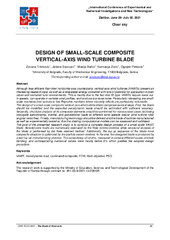Приказ основних података о документу
Design of small-scale composite vertical-axis wind turbine blade
| dc.creator | Trivković, Zorana | |
| dc.creator | Svorcan, Jelena | |
| dc.creator | Baltić, Marija | |
| dc.creator | Zorić, Nemanja | |
| dc.creator | Peković, Ognjen | |
| dc.date.accessioned | 2023-02-09T18:50:29Z | |
| dc.date.available | 2023-02-09T18:50:29Z | |
| dc.date.issued | 2021 | |
| dc.identifier.isbn | 978-86-6060-077-8 | |
| dc.identifier.uri | https://machinery.mas.bg.ac.rs/handle/123456789/4258 | |
| dc.description.abstract | Although less efficient than their horizontal-axis counterparts, vertical-axis wind turbines (VAWTs) present an interesting research topic as well as a renewable energy converter with lots of potential for application in both urban and secluded rural environments. This is mostly due to the fact that lift-type VAWTs require lower cut-in speeds, can operate in variable wind profiles, and produce low-level noise. Particularly interesting are small-scale machines that operate in low Reynolds numbers where viscosity effects are particularly noticeable. The design of a small-scale composite vertical-axis wind turbine blade comprises several steps. First, the blade should be modelled and the expected aerodynamic loads should be estimated with sufficient accuracy. Secondly, structural analysis of its composite elements should be performed for various load cases (including conjugate aerodynamic, inertial, and gravitational loads at different wind speeds and/or wind turbine rotor angular velocities). Finally, manufacturing technology should be defined and the blade should be manufactured as well as experimentally tested so that the starting computational models can be assessed and validated. The goal of the presented research study is to conduct a complete design process of a small-scale VAWT blade. Aerodynamic loads are numerically estimated by the finite volume method, while structural analysis of the blade is performed by the finite element method. Additionally, the lay-up sequence of the blade inner composite structure is optimized by the particle swarm method. In the end, the designed blade is produced by a wet lay-up manufacturing process. The consistency of strains, measured in several different cases of blade bending, and corresponding numerical values were mostly below 8% which justifies the adopted design procedure. | sr |
| dc.language.iso | en | sr |
| dc.publisher | Belgrade : Innovation Center of Faculty of Mechanical Engineering | sr |
| dc.relation | info:eu-repo/grantAgreement/MESTD/inst-2020/200105/RS// | sr |
| dc.rights | openAccess | sr |
| dc.source | The Book of Abstracts - International Conference of Experimental and Numerical Investigations and New Technologies CNN TECH | sr |
| dc.subject | VAWT | sr |
| dc.subject | Aerodynamic load | sr |
| dc.subject | Laminated composite | sr |
| dc.subject | FEM | sr |
| dc.subject | Multi-objective PSO | sr |
| dc.title | Design of small-scale composite vertical-axis wind turbine blade | sr |
| dc.type | conferenceObject | sr |
| dc.rights.license | ARR | sr |
| dc.citation.rank | M34 | |
| dc.citation.spage | 68 | |
| dc.identifier.fulltext | http://machinery.mas.bg.ac.rs/bitstream/id/10024/bitstream_10024.pdf | |
| dc.identifier.rcub | https://hdl.handle.net/21.15107/rcub_machinery_4258 | |
| dc.type.version | publishedVersion | sr |


